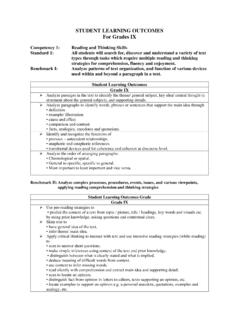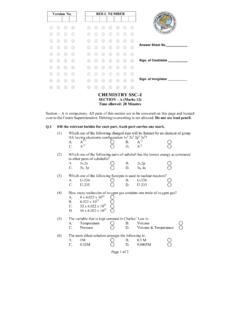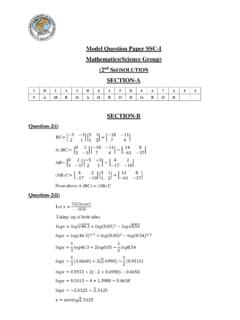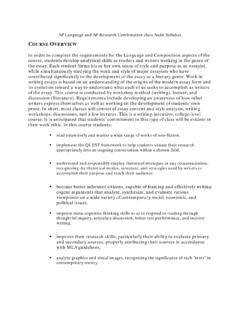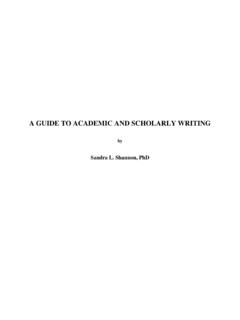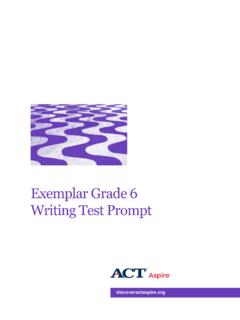Transcription of STUDENT LEARNING OUTCOMES For Grades X
1 STUDENT LEARNING OUTCOMES For Grades X Competency 1: Reading and Thinking Skills Standard 1: All students will search for, discover and understand a variety of text types through tasks which require multiple reading and thinking strategies for comprehension, fluency and enjoyment. Benchmark I: Analyze patterns of text organization, and function of various devices used within and beyond a paragraph in a text. STUDENT LEARNING OUTCOMES Grade X Analyze passages in the text to identify the theme/ general subject, key idea/ central thought (a statement about the general subject), and supporting details. Analyze paragraphs to identify words, phrases or sentences that support the main idea through definition example/ illustration cause and effect comparison and contrast facts, analogies, anecdotes and quotations.
2 Identify and recognize the functions of pronoun antecedent relationships. anaphoric and cataphoric references. transitional devices used for coherence and cohesion at discourse level. Analyze the order of arranging paragraphs: Chronological or spatial. General to specific, specific to general. Most important to least important and vice versa. Benchmark II: Analyze complex processes, procedures, events, issues, and various viewpoints, applying reading comprehension and thinking strategies STUDENT LEARNING OUTCOMES Grade Grade X Use pre-reading strategies to predict the content of a text from topic / picture, title / headings, key words and visuals etc. by using prior knowledge, asking questions and contextual clues. Skim text to have general idea of the text. infer theme/ main idea. Apply critical thinking to interact with text and use intensive reading strategies (while-reading) to scan to answer short questions.
3 Make simple inferences using context of the text and prior knowledge. distinguish between what is clearly stated and what is implied. deduce meaning of difficult words from context. use context to infer missing words. read silently with comprehension and extract main idea and supporting detail. scan to locate an opinion. distinguish fact from opinion in letters to editors, texts supporting an opinion, etc. locate examples to support an opinion a personal anecdote, quotations, examples and analogy, etc. recognize arguments and counter arguments. explore viewpoints/ ideas and issues. follow instructions in maps or user instruction manuals and forms related to extended social and academic environment. comprehend/interpret text by applying critical thinking. generate questions to understand text.
4 Use summary skills to extract salient points and develop a mind map to summarize a text. follow a process or procedure to summarize the information to transfer the written text to a diagram flow chart or cloze paragraph. Use critical thinking to respond orally and in writing to the text (post-reading) to give a personal opinion and justify stance related to viewpoints/ ideas and issues in the text read. relate what is read to his or her own feelings and experiences. explore causes and consequences of a problem or an issue and propose various solutions. evaluate material read. Apply strategies to comprehend questions by marking key words, verbs and tenses in a variety of question types: Literal/ textual/ factual Interpretive Inferential Evaluative Personal response Open ended Respond orally and in writing .
5 Benchmark III: Analyze information from a visual cue or a graphic organizer to show complex processes, procedures, comparisons, contrasts, and cause and effect relationships STUDENT LEARNING OUTCOMES Grade Grade X Interpret the situation in a visual cue and with the help of mind map giving vocabulary, structure and sensory details to write a short description. Analyze information in bar graphs, line graphs, and diagrams describing complex processes and procedures, comparisons and contrast to write a short written report. Organize information using various organizational patterns: sequence, comparison, contrast, classification, cause and effect. Recognize and use appropriate transitional words within and beyond paragraphs for better coherence and cohesion. Recognize and use appropriate conventions (format, style, expression) Benchmark IV: Gather, analyze, evaluate and synthesize information to use for a variety of purposes including a research project using various aids and study skills STUDENT LEARNING OUTCOMES Grade Grade X Use dictionaries to locate guide words.
6 Locate entry word. choose appropriate word definition. identify pronunciation through pronunciation key. identify syllable division, and stress pattern. identify parts of speech. identify correct spellings. identify phrases through key words. recognize abbreviations used in a dictionary. locate phrases and idioms. comprehend notes on usage. Locate appropriate synonyms and antonyms in a thesaurus. Use library skills to alphabetize book titles, words and names. locate fiction and non fiction books / books by subject. understand card catalogue. locate and use card catalogue. identify three kinds of catalogue cards author card, title card, subject card. use case and shelf labels in the library. use the reference section in the library. use computer catalogue Utilize effective study strategies note-taking / note-making, writing a summary and creating a mind map to organize idea Use textual aids such as table of contents, footnote, glossary, preface, sub headings etc.
7 To comprehend texts. identify and select relevant information in a book. Utilize appropriate informational sources including encyclopedias and internet sources. Competency 1: Reading and Thinking Skills Standard 2: All students will read and analyze literary text to seek information, ideas, enjoyment, and to relate their own experiences to those of common humanity as depicted in literature. Benchmark I: Analyze short stories, poems, and essays; make connections between literary texts and their own lives STUDENT LEARNING OUTCOMES Grade Grade X Read text to make predictions about story line / content, characters, using contextual clues and prior knowledge. Analyze story elements: characters, events, setting, plot, theme, tone, point of view. Identify the speaker or narrator in a selection. Recognize the author s purpose and point of view.
8 Read a text to make connections between their own lives and the characters, events, motives, and causes of conflict in texts. make inferences and draw conclusion about character using supportive evidence from the text. compare characters in a literary selection to near similar one s in real life. Recognize genres of literature, fiction, nonfiction, poetry, legend, myth. Read a poem and give orally and in writing Theme and its development. Personal response with justification. Paraphrase/ summary Read and analyze how a writer/ poet uses language to appeal to the senses through use of figurative language including similes and metaphors. affect meaning through use of synonyms with different connotations and denotations. create imagery. Read and recognize literary techniques such as repetition, personification and alliteration.
9 Competency 2: writing Skills Standard 1: All students will produce with developing fluency and accuracy, academic, transactional and creative writing , which is focused, purposeful and shows an insight into the writing process. Benchmark I: Analyze a variety of written discourse to use in their own compositions, techniques for effective text organization, development, and author s techniques that influence reader. STUDENT LEARNING OUTCOMES Grade Grade X Develop focus for own writing by identifying audience and purpose. Select and use a variety of pre- writing strategies such as brainstorming, mind mapping, outlining etc. Analyze an essay to identify the general subject, main idea (a statement about the general subject), key ideas, supporting details and transitional devices. Write an essay on a general subject: Write an introductory paragraph with a clear central thought.
10 Provide key ideas which prove, explain or support the central thought. Use a separate paragraph for each key idea. Incorporate evidence (facts, quotations, etc), examples (analogies, anecdotes, etc.), or different points of view (elaborating an idea/opinion) to support each key idea. Use appropriate transitional devices to connect ideas within and between paragraphs. Add a closing or summary paragraph with a synthesis of central idea, syntheses of each supporting idea, a general concluding statement. Use correct conventions of grammar and punctuation. Use appropriate vocabulary. Benchmark II: Write a variety of expository , persuasive, analytical essays, and personal narratives for different purposes and audiences. STUDENT LEARNING OUTCOMES Grade Grade X Analyze to use in their own writing , features of an expository composition showing comparison and contrast between things, events, situations, places, action, idea or a problem: Methods for organizing comparison and contrast.
